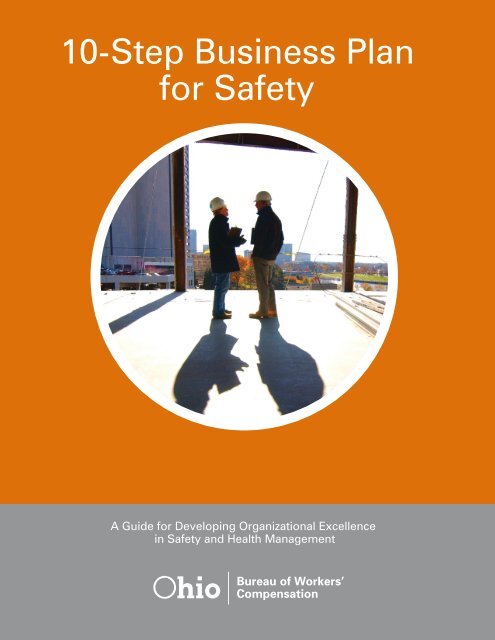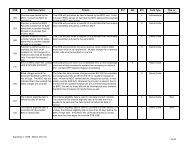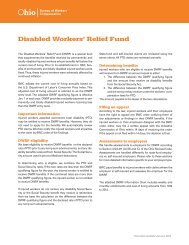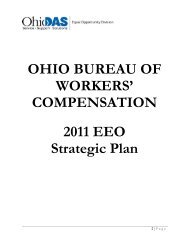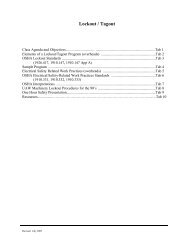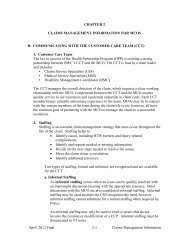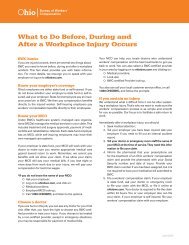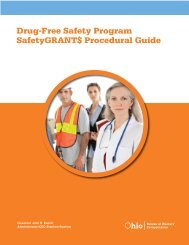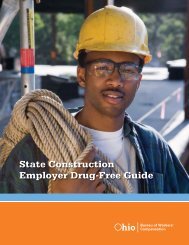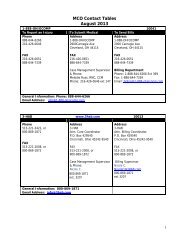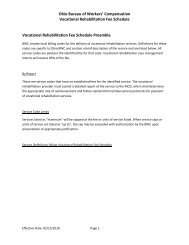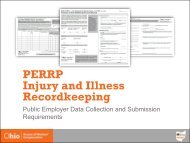BWC 10-Step Business Plan for Safety - Ohio Bureau of Workers ...
BWC 10-Step Business Plan for Safety - Ohio Bureau of Workers ...
BWC 10-Step Business Plan for Safety - Ohio Bureau of Workers ...
Create successful ePaper yourself
Turn your PDF publications into a flip-book with our unique Google optimized e-Paper software.
<strong>10</strong>-<strong>Step</strong> <strong>Business</strong> <strong>Plan</strong><br />
<strong>for</strong> <strong>Safety</strong><br />
A Guide <strong>for</strong> Developing Organizational Excellence<br />
in <strong>Safety</strong> and Health Management
<strong>10</strong> -<strong>Step</strong> - Table <strong>of</strong> Contentsontents<br />
1 Section I - Introduction<br />
How to use this manual<br />
Investing in an effective safety and health process<br />
3 Section II - <strong>10</strong>-<strong>Step</strong> <strong>Business</strong> <strong>Plan</strong> <strong>for</strong> <strong>Safety</strong><br />
1 Visible, active senior management leadership<br />
2 Employee involvement and recognition<br />
3 Medical treatment and return-to-work practices<br />
4 Communication<br />
5 Timely notification <strong>of</strong> claims<br />
6 <strong>Safety</strong> and health process coordination and employer education<br />
7 Written orientation and training plan<br />
8 Written and communicated safe work practices<br />
9 Written safety and health policy<br />
<strong>10</strong> Recordkeeping and data analysis<br />
14 Section III - Resource/reference<br />
15 Section IV - <strong>10</strong>-<strong>Step</strong> <strong>Business</strong> <strong>Plan</strong> <strong>for</strong> <strong>Safety</strong> Check List<br />
20 Integrating <strong>Safety</strong> into TQM<br />
<strong>10</strong>-<strong>Step</strong> <strong>Business</strong> <strong>for</strong> <strong>Safety</strong> <strong>Plan</strong> —<br />
A Guide <strong>for</strong> Developing Organizational Excellence<br />
in <strong>Safety</strong> and Health Management
Section I - Introductionontents<br />
How to use this manual<br />
Accident prevention will be most effective<br />
when every employee values and takes<br />
responsibility <strong>for</strong> safe job per<strong>for</strong>mance.<br />
To get employees to work safely and<br />
participate in safety management, safety<br />
programs must do more than require<br />
compliance. They must incorporate cultural<br />
change and stress behavior adjustment.<br />
The pay<strong>of</strong>f<br />
A culture where all members <strong>of</strong> the<br />
organization actively manage workplace safety<br />
and health.<br />
The results<br />
• Increased economic value <strong>for</strong> the<br />
organization<br />
• Reduced workers’ compensation costs<br />
• Increased safety awareness<br />
• Increased employee ownership <strong>for</strong><br />
success<br />
• Enhanced communication and trust<br />
• Lasting change in the culture<br />
The <strong>10</strong>-<strong>Step</strong> <strong>Business</strong> <strong>Plan</strong> <strong>for</strong> <strong>Safety</strong> is an<br />
integral part <strong>of</strong> the following <strong>BWC</strong> alternative<br />
rating plans:<br />
• Drug-Free Workplace Program (DFWP)<br />
• Drug-Free EZ Program (DF-EZ)<br />
• Individual-Retrospective-Rating <strong>Plan</strong><br />
• EM Capping<br />
We have developed the <strong>10</strong>-<strong>Step</strong> <strong>Business</strong> <strong>Plan</strong> <strong>for</strong> <strong>Safety</strong> with the<br />
goal <strong>of</strong> helping your company develop a culture where all members<br />
<strong>of</strong> the organization actively manage workplace safety and health.<br />
Use this manual and the <strong>10</strong>-<strong>Step</strong> <strong>Business</strong> <strong>Plan</strong> <strong>for</strong> <strong>Safety</strong> as a<br />
framework <strong>for</strong> your organization’s safety program.<br />
Successfully managing inherent hazards pertaining to your<br />
company requires all staff members understand the value placed<br />
on safety and health by the organization's leadership, understand<br />
their individual per<strong>for</strong>mance responsibilities and continue to<br />
acquire knowledge in safety and health.<br />
Integrating the <strong>10</strong>-<strong>Step</strong> <strong>Business</strong> <strong>Plan</strong> <strong>for</strong> <strong>Safety</strong> into the way you<br />
conduct business will help you develop a new safety culture and<br />
identify safety as a core organizational value.<br />
The manual’s first section introduces the <strong>10</strong>-<strong>Step</strong> <strong>Business</strong> <strong>Plan</strong><br />
<strong>for</strong> <strong>Safety</strong> and discusses reasons <strong>for</strong> developing sound safetyand-health<br />
management approaches to accident prevention and<br />
cost containment. Section II defines each step <strong>of</strong> the <strong>10</strong>-<strong>Step</strong><br />
<strong>Business</strong> <strong>Plan</strong> <strong>for</strong> <strong>Safety</strong> and includes requirements and additional<br />
implementation suggestions. The third section includes the<br />
resources to help you find additional in<strong>for</strong>mation in specific areas.<br />
The <strong>10</strong>-<strong>Step</strong> <strong>Business</strong> <strong>Plan</strong> <strong>for</strong> <strong>Safety</strong> Check List, is <strong>for</strong> your internal<br />
use in tracking your progress toward developing accidentprevention<br />
systems and processes.<br />
1<br />
<strong>10</strong>-<strong>Step</strong> <strong>Business</strong> <strong>Plan</strong> <strong>for</strong> <strong>Safety</strong> — A Guide <strong>for</strong> Developing Organizational Excellence in <strong>Safety</strong> and Health Management
Investing in an effective<br />
safety and health process<br />
Ineffective accident prevention leads to occupational injuries and<br />
illnesses. As a result, workers’ compensation insurance costs<br />
skyrocket and pr<strong>of</strong>its plummet. It is not unusual to see a company<br />
with poor injury and illness per<strong>for</strong>mance pay three or four times<br />
the insurance premium its competitors pay.<br />
The costs <strong>of</strong> injuries and illnesses include medical bills, rehabilitation<br />
costs, disability payments and lost-time benefits. These costs,<br />
however, are <strong>of</strong>ten just the beginning <strong>of</strong> expense <strong>for</strong> the employer.<br />
The hidden costs <strong>of</strong> injuries and illnesses may range from four to<br />
<strong>10</strong> times the direct costs.<br />
On-the-job injuries and illnesses have an<br />
adverse effect on both public and employee<br />
relations. While a company's safety<br />
achievements <strong>of</strong>ten go unnoticed, a<br />
catastrophic accident people may<br />
remember long after the incident.<br />
You can strengthen employee relations by<br />
showing employees you sincerely care<br />
about them.<br />
Indirect costs resulting from injuries include:<br />
• Administrative costs;<br />
• Failure to meet schedules;<br />
• Loss <strong>of</strong> production/service capability;<br />
• Overhead costs that continue while work is disrupted;<br />
• Spoiled or damaged product;<br />
• Damaged tools and equipment;<br />
• Loss <strong>of</strong> efficiency due to breakup <strong>of</strong> crew;<br />
• Cost <strong>of</strong> training a replacement worker;<br />
• Lost staff time.<br />
Employees feel better about their jobs and<br />
about themselves when they have a strong<br />
sense that the organization cares. By<br />
implementing managed approaches to<br />
accident prevention, an employer shows<br />
his or her employees that he or she does<br />
care. As a result your work <strong>for</strong>ce may<br />
display improved morale, lower<br />
absenteeism and higher productivity.<br />
Correcting unsafe conditions and complying<br />
with Occupational <strong>Safety</strong> and Health<br />
Administration (OSHA) regulations do not<br />
ensure success in accident prevention.<br />
<strong>Workers</strong> must make decisions to per<strong>for</strong>m<br />
their tasks safely. Those decisions are made<br />
hundreds <strong>of</strong> times daily. When the<br />
organization’s work <strong>for</strong>ce truly believes<br />
safety is in their best interest, permanent<br />
per<strong>for</strong>mance improvements occur and<br />
safety becomes a core value and part <strong>of</strong><br />
the organizational culture.<br />
2
tSection I - <strong>10</strong>-<strong>Step</strong> <strong>Business</strong> <strong>Plan</strong><br />
1 Visible,<br />
active senior management<br />
Visible senior management leadership within your organization<br />
promotes safety management as an organizational value<br />
Requirements<br />
Senior management, including the top<br />
executive on-site, must act as role models <strong>for</strong><br />
how all employees should work to create a<br />
safe work environment.<br />
Active leadership includes:<br />
• Authorizing the necessary resources <strong>for</strong><br />
accident prevention;<br />
• Discussing safety processes and<br />
improvements regularly during staff or<br />
employee meetings;<br />
• Ensuring management is held accountable<br />
<strong>for</strong> accident-prevention activities and <strong>for</strong><br />
managing accident-prevention processes;<br />
• Annually assessing the success <strong>of</strong> the<br />
safety process by using surveys, personal<br />
interviews and/or behavior-sampling;<br />
• Encouraging employees to take an active<br />
part in maintaining a safe workplace.<br />
Implementation<br />
Senior management will establish the importance <strong>of</strong> safety<br />
in all operations. Taking the safety and health lead,<br />
management helps in the campaign to reduce accident<br />
losses. Senior management’s leadership, support and<br />
active commitment encourage management and<br />
employees to make the safety and health system successful.<br />
Senior management should take these actions to show<br />
active leadership in the safety and health processes:<br />
• Issue a written safety policy as a core value <strong>of</strong><br />
the organization and assign roles and responsibilities;<br />
• Establish both annual and long-term safety goals;<br />
• Include safety as an agenda item in all regularly<br />
scheduled business meetings;<br />
• Regularly review progress <strong>of</strong> the safety and health<br />
processes with supervisors and employees;<br />
• Accompany supervisors, safety team members or<br />
safety committee members during periodic<br />
departmental safety surveys;<br />
• Review and discuss all accident-investigation<br />
reports with the supervisor or <strong>for</strong>eman;<br />
• Present safety recognition awards to deserving<br />
employees;<br />
• Openly discuss safety issues with employees during<br />
periodic tours or meetings;<br />
• Participate as a student in employee safety training<br />
programs;<br />
• Participate in meetings with accident-prevention<br />
coordinators;<br />
3<br />
<strong>10</strong>-<strong>Step</strong> <strong>Business</strong> <strong>Plan</strong> <strong>for</strong> <strong>Safety</strong> — A Guide <strong>for</strong> Developing Organizational Excellence in <strong>Safety</strong> and Health Management
2<br />
Employee<br />
involvement<br />
and recognition<br />
Employee involvement and<br />
recognition af<strong>for</strong>d employees<br />
opportunities to participate in the<br />
safety-management process<br />
Requirements<br />
To ensure the effectiveness <strong>of</strong> the program, both<br />
management and employees will participate in the safetyand-health<br />
management process.<br />
Employee participation opportunities can include:<br />
• <strong>Safety</strong> and health involvement teams, focus groups,<br />
or safety and health committees;<br />
• Accident investigations;<br />
• <strong>Safety</strong> and health audits;<br />
• Acting as instructors <strong>for</strong> safety and health training<br />
programs.<br />
Recognition opportunities can include:<br />
• Recognizing employees <strong>for</strong> excellence in accident<br />
prevention;<br />
• Recognizing employees <strong>for</strong> consistently high<br />
contribution to safety and health;<br />
• Recognizing employees <strong>for</strong> their contributions to<br />
continuous improvement through participation in<br />
problem solving, decision making or perception surveys;<br />
• Recognizing employees who suggest safety and<br />
health improvements or complete safety and<br />
health projects.<br />
Recognition<br />
Two methods that encourage employees to use safe<br />
work practices and to integrate safety into the fabric <strong>of</strong><br />
their jobs are:<br />
• Positive safe behavior rein<strong>for</strong>cement — recognize<br />
employees <strong>for</strong> their actions in integrating safety into<br />
business operations and making the right decisions.<br />
Expressing gratitude and complimenting employees <strong>for</strong><br />
their safe per<strong>for</strong>mance encourages continued safe<br />
behaviors;<br />
• Negative safe behavior rein<strong>for</strong>cement — discipline<br />
employees <strong>for</strong> their actions and poor decisions.<br />
Disciplining discourages unsafe behaviors and<br />
decisions, and prevents behaviors in the future.<br />
Implementation<br />
Labor/management safety and health teams facilitate dialogue on<br />
safety and health matters between management and nonmanagement<br />
employees. The safety involvement team handles<br />
problem solving and decision making <strong>for</strong> safety and health issues<br />
confronting the company. Team composition includes management<br />
and direct labor employees in roughly equal numbers. Team<br />
members represent all areas <strong>of</strong> the company and participate as<br />
equals. Teams may be natural work groups, associated with a single<br />
function area or cross-functional and represent a variety <strong>of</strong> work<br />
areas.<br />
Objectives include:<br />
• Prepare and make available records <strong>of</strong> the safety and health<br />
issues, and outcomes discussed during meetings;<br />
• Use recognized problem-solving techniques, like brainstorming,<br />
cause-and-effect diagrams, decision analysis, charting, etc.,<br />
to reach effective solutions;<br />
• Review investigations <strong>of</strong> accidents and causes <strong>of</strong> incidents<br />
resulting in injury, illness or exposure to hazardous substances,<br />
and recommend specific action plans <strong>for</strong> prevention;<br />
• Recommend specific actions in response to employee safety<br />
suggestions;<br />
• Conduct surveys <strong>of</strong> the safety culture every 12 to 18 months.<br />
The team should meet regularly but not less than quarterly with<br />
the facilitator. The facilitator should be a member <strong>of</strong> the team who<br />
schedules the meeting, arranges <strong>for</strong> a meeting place and notifies<br />
members <strong>of</strong> the meeting. Rotate the facilitation role frequently and<br />
share responsibility <strong>for</strong> other team functions among team members.<br />
Record the minutes <strong>of</strong> each meeting and distribute the minutes to<br />
all team members. Post a copy <strong>of</strong> the minutes on the company<br />
safety bulletin board.<br />
Giving the safety team the responsibility to make decisions and the<br />
accountability <strong>for</strong> implementing solutions is important. Empower<br />
the team to be responsible <strong>for</strong> developing and implementing effective<br />
safety solutions.<br />
You should use both positive and negative rein<strong>for</strong>cement to<br />
encourage employees to per<strong>for</strong>m their jobs safely. However, the<br />
tendency is to dwell on the negative. This leads to fault finding<br />
and blaming employees. Thus, safety is perceived as a negative<br />
by supervisors and employees. Heavily involving employees and<br />
using safe-behavior rein<strong>for</strong>cement develops a positive approach<br />
to managing the safety process.<br />
You may consider asking supervisors to recognize and praise at<br />
least one employee each day <strong>for</strong> following prescribed safe work<br />
practices or contributing support to the accident-prevention<br />
systems. Recognition costs nothing but is a visible reminder <strong>of</strong><br />
the importance the supervisor and the organization place on<br />
integrating safety into the culture <strong>of</strong> the organization and into dayto-day<br />
operations.<br />
4
Section II - <strong>10</strong>-<strong>Step</strong> <strong>Business</strong> <strong>Plan</strong> <strong>for</strong> <strong>Safety</strong><br />
3<br />
Medical treatment and return-to-work practices<br />
Early return-to-work strategies help injured or ill workers<br />
Medical treatment<br />
Implementation<br />
Quality medical care provided in a timely manner helps injured employees<br />
and promotes claims-cost containment. Establishing effective working<br />
relationships with health-care providers is crucial <strong>for</strong> overall success.<br />
Take the following steps to facilitate the medical process and provide<br />
early intervention and successful medical management:<br />
• Create effective open lines <strong>of</strong> communication with a clinic, hospital<br />
or physician;<br />
• Educate health-care providers about the nature <strong>of</strong> your business,<br />
its risks and your control strategies;<br />
• Build strong working relationships with health-care providers so<br />
each party understands roles, responsibilities and expectations.<br />
Medical treatment<br />
Requirements<br />
Establish a post-injury or disability management policy and procedure.<br />
The policy and procedure will be consistent with the Health Partnership<br />
Program (HPP) to help injured or ill employees obtain quality medical care<br />
and return to work.<br />
Components <strong>of</strong> the disability management procedure will include, at a<br />
minimum:<br />
• In<strong>for</strong>ming employees <strong>of</strong> procedures <strong>for</strong> obtaining medical treatment,<br />
including in<strong>for</strong>ming employees <strong>of</strong> the selected managed care organization<br />
(MCO);<br />
• Immediate reporting <strong>of</strong> injuries and illnesses to a supervisor;<br />
• Regular communication with injured or ill employees who are <strong>of</strong>f work;<br />
• Investigation <strong>of</strong> all injuries or illnesses within 24 hours to identify process<br />
and corrective measures;<br />
• When not prohibited by labor agreement, a modified-duty or transitionalwork<br />
program that allows employees to return to work in a productive<br />
capacity during the recuperative period.<br />
5<br />
<strong>10</strong>-<strong>Step</strong> <strong>Business</strong> <strong>Plan</strong> <strong>for</strong> <strong>Safety</strong> — A Guide <strong>for</strong> Developing Organizational Excellence in <strong>Safety</strong> and Health Management
Return-to-work<br />
practices/rehabilitation guidelines<br />
Requirements<br />
Establish a pre-injury planning process to help workers minimize<br />
the impact <strong>of</strong> work-related injuries or illness. Components <strong>of</strong><br />
the pre-injury planning process will include:<br />
• Educating workers and supervisors on safety procedures<br />
and acquainting them with the workers’ compensation<br />
system and company process;<br />
• Developing a company remain-at-work plan that creates<br />
a work-site job analysis <strong>for</strong> each worker or job<br />
classification. This documentation provides guidelines<br />
<strong>for</strong> decision making in the development <strong>of</strong> modifiedor<br />
transitional-duty programs with the ultimate goal<br />
<strong>of</strong> helping the injured worker remain at work post injury;<br />
• Communicating, monitoring and evaluating the<br />
company’s remain-at-work plan.<br />
Establish a post-injury or disability-management policy to help<br />
injured workers obtain quality medical care and return to work<br />
quickly. This return-to-work plan will clearly outline strategies<br />
<strong>for</strong> returning workers to active status after injury or illness as<br />
soon as medically feasible.<br />
Components will include:<br />
• A process <strong>for</strong> the worker to immediately report a workrelated<br />
injury or illness to his or her supervisor;<br />
• Procedures <strong>for</strong> the worker to obtain quality, timely<br />
medical treatment;<br />
• A procedure <strong>for</strong> the employer to manage the worker’s<br />
return to the work site. This includes regular<br />
communication with injured employees who are <strong>of</strong>f work;<br />
• A process <strong>for</strong> the employer to determine the worker’s<br />
readiness to return to work in conjunction with the<br />
worker’s medical and/or rehabilitation provider;<br />
• A method <strong>for</strong> the employer to monitor the worker upon<br />
return to work to reduce potential <strong>of</strong> re-injury;<br />
• A process <strong>for</strong> the employer to investigate all injuries<br />
or illnesses within 24 hours to identify process<br />
improvements and corrective measures;<br />
• A course <strong>for</strong> implementing a modified- or transitionalduty<br />
program, when not prohibited by a labor agreement,<br />
that allows workers to return to work in a productive<br />
capacity during the recuperative period.<br />
Implementation<br />
Taking a proactive approach and establishing effective working<br />
relationships with the involved health-care and rehabilitation<br />
providers is crucial <strong>for</strong> overall success. These steps facilitate the<br />
medical process and serve as the foundation <strong>for</strong> early intervention<br />
and successful medical management:<br />
Work-site job analysis<br />
A work-site job analysis will be a valuable tool to develop modified<br />
or transitional-duty programs. Develop and communicate the<br />
work-site job analysis prior to injury. You may use a rehabilitation<br />
specialist, such as an occupational therapist, to create the analyses<br />
and provide recommendations <strong>for</strong> physically appropriate modified<br />
duties given the injured workers’ functional capabilities.<br />
Include the following attributes <strong>of</strong> the workers’ responsibilities<br />
in each analysis:<br />
• Job description, including task details;<br />
• Detail <strong>of</strong> tools and equipment used;<br />
• Work schedule;<br />
• Analysis <strong>of</strong> physical demands <strong>for</strong> required tasks;<br />
• Other special demands.<br />
Using the work-site job analysis, you can implement an effective<br />
modified- or transitional-duty program. Such a program facilitates<br />
a worker's return to work as soon as he or she can work in a<br />
productive capacity.<br />
Work closely with the worker’s health-care provider, rehabilitation<br />
specialist and claim administrator to determine the best possible<br />
solution <strong>for</strong> each individual worker.<br />
This may include:<br />
• Comparing the employee’s functional capabilities to the<br />
stated job requirements;<br />
• Deciding to what extent you can modify the job;<br />
• Identifying other modified-duty opportunities on a limited<br />
or full-time basis, if modification <strong>of</strong> the worker’s original<br />
job is not possible.<br />
Expected outcomes <strong>of</strong> implementing these requirements:<br />
• Reduced time lost from work;<br />
• Reduced productivity loss;<br />
• Improved return-to-work rate;<br />
• Reduced worker re-injury;<br />
• Increased worker satisfaction;<br />
• Reduced costs.<br />
6
Section II - <strong>10</strong>-<strong>Step</strong> <strong>Business</strong> <strong>Plan</strong> <strong>for</strong> <strong>Safety</strong><br />
4<br />
Communication<br />
Regular safety-and-health communication<br />
keeps employees in<strong>for</strong>med and solicits<br />
feedback and suggestions<br />
Requirements<br />
Your organization’s approach to managing safety and health<br />
will include regular verbal and written communication on<br />
matters affecting employee safety and health.<br />
Communication will include:<br />
• Quarterly written and/or verbal feedback to all<br />
employees on their accident-prevention per<strong>for</strong>mance;<br />
• A process <strong>for</strong> upward and downward communication<br />
throughout the organization;<br />
• Communication can include memos, bulletin boards,<br />
staff and general meetings;<br />
• Feedback should include the organization’s overall<br />
safety and health per<strong>for</strong>mance.<br />
Implementation<br />
<strong>Safety</strong> communication is a two-way process between employer<br />
and employees. Many traditional safety programs emphasize topdown<br />
communication and virtually overlook communication from<br />
the bottom up. To have an effective safety program, you must<br />
incorporate a bottom-up communication process.<br />
Encourage employees to identify obstacles to safety without fear<br />
<strong>of</strong> reprisal. It is crucial that you develop and nurture a system <strong>of</strong><br />
open and honest communication <strong>for</strong> a safety culture to evolve.<br />
Soliciting employee input and participation on safety-and-health<br />
matters will do more than simply help the organization communicate<br />
more effectively.<br />
Encouraging employees to share their ideas and concerns on<br />
safety-and-health matters. Asking them <strong>for</strong> their help in decisionmaking<br />
and problem solving will help them not only feel in on<br />
things, but actually contribute to successful outcomes. High morale<br />
and productivity also result.<br />
Communication with employees needs to be easily understood.<br />
If you have languages other than English spoken in your facilities,<br />
communicate safety and health in<strong>for</strong>mation to employees in the<br />
language they understand. In addition, some employees may not<br />
read, requiring verbal communication.<br />
Whatever communication strategies you use, it is important that<br />
employee concerns and suggestions receive timely and appropriate<br />
responses. It also is important that employees feel they are being<br />
heard and that their opinions matter.<br />
The following communication ideas will help you design your<br />
communication systems and processes:<br />
• One-on-one discussion — the supervisor, <strong>for</strong>eman or team<br />
leader sits down with each employee on a scheduled basis<br />
to discuss safety concerns, suggestions and ideas. Dialogue<br />
can last from <strong>10</strong> minutes to one hour. Ideally, you should hold<br />
discussions monthly;<br />
• In<strong>for</strong>mal discussion — in<strong>for</strong>m employees that the accidentprevention<br />
coordinator, supervisor and/or team leader is<br />
available to discuss confidentially their safety and health<br />
questions, problems and suggestions;<br />
• Suggestions — establish a safety-and-health suggestion<br />
program. Install a safety suggestion box in the work area<br />
and ask employees to contribute their comments and<br />
suggestions. Consider providing a <strong>for</strong>m <strong>for</strong> employees to use<br />
when submitting their suggestions;<br />
• Group discussion — provide the opportunity <strong>for</strong> executives,<br />
supervisors, team leaders and employees to discuss safety<br />
issues at employee gatherings. Regularly schedule meetings<br />
to share in<strong>for</strong>mation and seek input on safety and health<br />
matters. Meetings can be <strong>for</strong>mal or in<strong>for</strong>mal, held in a<br />
conference room or on the job site, last long or be done in<br />
<strong>10</strong> minutes;<br />
• Written communication — communicate key in<strong>for</strong>mation,<br />
which can be motivational, developmental or in<strong>for</strong>mative,<br />
in writing;<br />
• In-house company publications — an in-house company<br />
newsletter provides accident-prevention in<strong>for</strong>mation on a<br />
regular basis;<br />
• <strong>Safety</strong> and health booklets — provide safety-and-health<br />
in<strong>for</strong>mation to employees at work or mail to their homes;<br />
• <strong>Safety</strong> alert notices — in<strong>for</strong>m employees <strong>of</strong> accident causes<br />
and how they can prevent them. Discuss the alert notices<br />
with employees, post notices on the safety bulletin board<br />
or send them to individual employees;<br />
• Memorandums — summarize discussions and plans, provide<br />
in<strong>for</strong>mation on per<strong>for</strong>mance goals and expectations, and<br />
give feedback on safety per<strong>for</strong>mance;<br />
• <strong>Safety</strong> bulletin boards — use <strong>for</strong> posting safety-related<br />
policies, notices, articles, meeting schedules, meeting<br />
minutes, memos, etc.;<br />
• <strong>Safety</strong> signs — a constant reminder <strong>of</strong> safe work practices,<br />
dangerous conditions and special precautions. Post safety<br />
signs as reminders on machinery, entrancesto work areas and<br />
in high hazard areas.<br />
7<br />
<strong>10</strong>-<strong>Step</strong> <strong>Business</strong> <strong>Plan</strong> <strong>for</strong> <strong>Safety</strong> — A Guide <strong>for</strong> Developing Organizational Excellence in <strong>Safety</strong> and Health Management
5<br />
Timely notification <strong>of</strong> claims<br />
Requirements<br />
You must report claims immediately to the MCO, which reports the claim to us<br />
within 24 hours.<br />
You will comply with all requirements <strong>for</strong> reporting claims to the your MCO as<br />
specified under the HPP rules.<br />
Implementation<br />
When an injury occurs, first arrange <strong>for</strong> medical care <strong>for</strong> the employee. Next,<br />
investigate and document the circumstances, and report the injury to the claim<br />
handler.<br />
Reporting claims quickly:<br />
• Demonstrates care and concern <strong>for</strong> the employee;<br />
• Prevents delays and/or confusion in the claim process;<br />
• Reduces the potential <strong>for</strong> fraud or abuse;<br />
• Reduces the potential <strong>for</strong> needless litigation.<br />
Through timely reporting <strong>of</strong> claims, you:<br />
• Establish an open line <strong>of</strong> communication;<br />
• Develop accurate in<strong>for</strong>mation to manage the workers' compensation claim;<br />
• Provide benefits to the injured employee on a timely basis.<br />
8
Section II - <strong>10</strong>-<strong>Step</strong> <strong>Business</strong> <strong>Plan</strong> <strong>for</strong> <strong>Safety</strong><br />
6<br />
<strong>Safety</strong> and health process coordination<br />
and employer education<br />
Assign the role <strong>of</strong> coordinating safety ef<strong>for</strong>ts <strong>for</strong> the company<br />
Requirements<br />
Designate an individual as the accidentprevention<br />
coordinator. Give that person the<br />
responsibility and authority to facilitate<br />
organizational safety systems and processes.<br />
Ensure he or she develops the knowledge<br />
and skills necessary <strong>for</strong> creating a safer<br />
working environment.<br />
The accident-prevention coordinator does<br />
not assume operational responsibility <strong>for</strong><br />
safety and health, but supports line<br />
management, supervision and employees to<br />
develop effective safety systems and<br />
processes.<br />
In addition, the accident-prevention<br />
coordinator must attend in person, at least<br />
one <strong>of</strong> our approved safety-and-health<br />
management courses yearly. Web-based<br />
classes are not acceptable.<br />
Responsibilities include:<br />
• Helping management and employees<br />
identify accident-prevention and safetyand-health<br />
training needs through<br />
perception surveys, interviews, behavior<br />
sampling or other similar methods;<br />
• Helping supervisors make changes or<br />
develop strategies that improve the<br />
organization's safety systems and<br />
processes;<br />
• Identifying and communicating new<br />
safety-and-health requirements;<br />
• Compiling injury and illness-related<br />
records;<br />
• Tracking progress on safety-and-healthrelated<br />
projects;<br />
• Working with employees to optimize safe<br />
work practices;<br />
• Attending in person, at least one <strong>of</strong> our<br />
approved safety and health management<br />
courses yearly.<br />
You may choose to delegate the accident-prevention coordinator’s functions<br />
to more than one employee. A small–business owner may assume the<br />
duties or have a manager do them in addition to his or her normal<br />
management duties. Geographically dispersed companies usually name a<br />
local employee as the accident-prevention coordinator. Medium-sized<br />
employers <strong>of</strong>ten designate a department manager from the human resource,<br />
engineering or financial services disciplines as their accident-prevention<br />
coordinator.<br />
Larger companies <strong>of</strong>ten employ a full-time accident-prevention coordinator.<br />
When determining the need <strong>for</strong> a full-time accident-prevention coordinator,<br />
consider the accident history, expenses associated with accidents and the<br />
degree <strong>of</strong> hazard inherent in the operations.<br />
As mentioned, accident-prevention coordinators must attend at least one<br />
<strong>of</strong> our approved safety-and-health management courses each year to<br />
meet the requirements <strong>of</strong> step 6. Our Division <strong>of</strong> <strong>Safety</strong> & Hygiene <strong>of</strong>fers<br />
several seminars that meet this requirement. An employer may select a<br />
seminar that best addresses his or her needs. To obtain more in<strong>for</strong>mation,<br />
call 1-800-OHIO<strong>BWC</strong>, and listen to the options.<br />
The accident-prevention coordinator should be committed to safety and<br />
health, employee well-being and have the time, authority and resources to<br />
facilitate the company's safety systems and processes. He or she acts as<br />
the internal consultant helping the organization make important safetyrelated<br />
decisions.<br />
Attending in person, at least one <strong>of</strong> our approved courses each year allows<br />
the accident-prevention coordinator to:<br />
• Increase expertise in safety systems and processes;<br />
• Renew/refresh thinking on how to develop successful<br />
management approaches;<br />
• Provide opportunity to understand how others are coping with<br />
similar challenges.<br />
Document all <strong>of</strong> our approved safety-and-health management courses the<br />
accident-prevention coordinator attends. The accident-prevention coordinator<br />
is an internal consultant, not a doer. Line managers and supervisors carry<br />
out many <strong>of</strong> the activities that make up the safety and health system. The<br />
accident-prevention coordinator provides advice and support to line<br />
managers, supervisors and employees regarding safety management<br />
responsibilities. An accident-prevention coordinator's specific functions<br />
may vary from company to company.<br />
9<br />
<strong>10</strong>-<strong>Step</strong> <strong>Business</strong> <strong>Plan</strong> <strong>for</strong> <strong>Safety</strong> — A Guide <strong>for</strong> Developing Organizational Excellence in <strong>Safety</strong> and Health Management
7<br />
Written orientation and training plan<br />
Conduct orientation and training <strong>for</strong> all employees<br />
Requirements<br />
Identify and respond to the specific training needs <strong>of</strong> your employees, including supervisors,<br />
managers and team leaders. Develop a written safety-and-health training plan that documents<br />
specific training objectives and instruction procedures.<br />
The safety-and-health training plan will include:<br />
• Company safety and health policy statement;<br />
• Employee responsibilities.<br />
<strong>Safety</strong>-and-health training will include:<br />
• Hazard communication;<br />
• Bloodborne pathogens, if applicable;<br />
• Specific job/task safe work practices and hazard recognition;<br />
• Recordkeeping.<br />
At a minimum, training must cover:<br />
• Procedures <strong>for</strong> the safe and efficient use <strong>of</strong> machinery and tools;<br />
• Ergonomic risk factors, including the prevention <strong>of</strong> cumulative trauma disorders;<br />
• Chemical hazards and how to prevent contact or exposure;<br />
• If appropriate, procedures <strong>for</strong> lockout-tagout, hot work permits and confined-space entry.<br />
Implementation<br />
No matter how safe a work environment you provide, the<br />
success <strong>of</strong> your safety-and-health systems depends upon the<br />
managers, supervisors, team leaders and employee buy-in <strong>of</strong><br />
safe work practices.<br />
The goal <strong>of</strong> any safety and health training program is not just to impart<br />
knowledge, but also to change behaviors and improve decision<br />
making. Through safety training, employees receive in<strong>for</strong>mation about<br />
hazards, procedures, processes and expected behaviors.<br />
<strong>Bureau</strong> <strong>of</strong> Labor Statistics studies have found that 48 percent<br />
<strong>of</strong> all injured workers had been on the job <strong>for</strong> less than one<br />
year. There<strong>for</strong>e, you should assume that new employees know<br />
little or nothing about the job hazards and processes associated<br />
with their job functions.<br />
After your new employees participate in safety orientation,<br />
have their supervisors provide them with job-specific safety<br />
and health training. Do not permit employees to start a job<br />
until they have received instructions on how to per<strong>for</strong>m the<br />
work safely. We recommend you give employees at least three<br />
days <strong>of</strong> training to ensure they understand the training and<br />
are following the proper procedures.<br />
Other than new employees, participants also will provide<br />
training in the following instances:<br />
• Provide employees with a general safety-and-health<br />
orientation, and job-specific safety-and-health training,<br />
similar to the orientation and training provided to new<br />
employees;<br />
• Provide employees who are given a new job assignment<br />
or transfer with the same job-specific safety-and-health<br />
training as if they were new employees. Often, transferred<br />
employees are not given safety training because they are<br />
only temporarily filling in <strong>for</strong> the regular employee.<br />
You must train temporary employees, or the potential <strong>for</strong><br />
an accident increases;<br />
• Conduct safety-and-health training be<strong>for</strong>e or at the time<br />
<strong>of</strong> introducing new substances, equipment, processes or<br />
procedures. Training may be an in<strong>for</strong>mal safety meeting<br />
held at the workplace. The training must be responsive<br />
to changes in the work environment;<br />
• Provide safety training whenever you identify a new or<br />
previously unrecognized hazard. Teach employees who<br />
may be exposed to the hazard how to protect themselves.<br />
Also encourage employees to report potential hazards<br />
immediately.<br />
In addition, it is important to build supervisor and manager<br />
competency levels in safety-and-health. As they emphasize<br />
and learn more about effective safety-process management,<br />
employees are less likely to be injured or become ill from<br />
inherent hazards.<br />
Fully document your safety and health training by including<br />
the date, topics covered, instructor’s name and the names <strong>of</strong><br />
employees attending the training session. Have employees<br />
answer written questions about the content <strong>of</strong> educational<br />
material you presented. This helps provide a sense <strong>of</strong><br />
importance to the training, measures understanding and<br />
retention <strong>of</strong> the material and documents the effectiveness <strong>of</strong><br />
the training. It also provides the opportunity <strong>for</strong> constructive<br />
feedback from the employees. Have each employee in<br />
attendance sign the documentation <strong>for</strong>m on the day <strong>of</strong><br />
completion.<br />
<strong>10</strong>
Section II - <strong>10</strong>-<strong>Step</strong> <strong>Business</strong> <strong>Plan</strong> <strong>for</strong> <strong>Safety</strong><br />
8<br />
Written and communicated safe work practices<br />
Publish safe work practices so employees have a clear<br />
understanding <strong>of</strong> how to accomplish their job requirements safely.<br />
Requirements<br />
Identify, document and publicize both general<br />
and job-specific safe work practices. Provide<br />
employees with a copy <strong>of</strong> the general safe<br />
work practices, and have all employees sign<br />
a statement indicating they have read and<br />
intend to follow the safe work practices.<br />
Examples <strong>of</strong> general safe work practices<br />
expected <strong>of</strong> employees include:<br />
• Practicing good housekeeping;<br />
• Wearing personal protective equipment;<br />
• Applying first-aid procedures (if trained);<br />
• Using good ergonomic principles;<br />
• Wearing respiratory protection;<br />
• Using and following lockout/tagout<br />
procedures;<br />
• Using and following confined-space<br />
entry;<br />
• Using hazard communication;<br />
• Avoiding bloodborne pathogens, if<br />
applicable.<br />
Implementation<br />
Safe work practices are essential <strong>for</strong> any organization because<br />
they prescribe the accepted behavior and practices the employer<br />
expects <strong>of</strong> employees. You may use a safety involvement team<br />
to develop an employee safety handbook. Ask employees <strong>for</strong><br />
their input in composing the handbook. Include general, companywide<br />
safe work practices and specific safe work practices that<br />
apply to each department, the company's safety policy or a<br />
statement on safety as viewed by the top <strong>of</strong>ficial <strong>of</strong> the<br />
organization in the safety handbook.<br />
Each department manager, leader, etc., will review the safe work<br />
practices with his or her employees on a recurring basis, at least<br />
annually.<br />
To help ensure employees read safe work practice handbooks , have<br />
your employees sign a statement certifying they have read it, they<br />
are familiar with the safety rules and policies outlined in the safety<br />
handbook and agree to abide by them. Retain the signed document<br />
in the employee’s personnel file.<br />
Job-specific, safe work practices apply to<br />
operations that involve recognized hazards<br />
and address risks associated with the<br />
business. Post or publicize job-specific safe<br />
work practices in the work area.<br />
11<br />
<strong>10</strong>-<strong>Step</strong> <strong>Business</strong> <strong>Plan</strong> <strong>for</strong> <strong>Safety</strong> — A Guide <strong>for</strong> Developing Organizational Excellence in <strong>Safety</strong> and Health Management
9<br />
Written safety and health policy<br />
A written safety-and-health policy signed by the top company <strong>of</strong>ficial<br />
expresses the employer’s values and commitment to workplace<br />
safety and health<br />
Requirements<br />
Give all new hires a safety-and-health<br />
policy document signed by the company’s<br />
top executive. Communicate the safetyand-health<br />
policy to all employees and<br />
review it with them on an annual basis.<br />
The document will include:<br />
• Managers, supervisors, team leaders<br />
and employees’ responsibilities<br />
regarding the organization’s<br />
commitment to workplace safety-andhealth;<br />
• Commitment to returning injured or<br />
ill employees to work at the earliest<br />
opportunity.<br />
Implementation<br />
A written safety-and-health policy clearly states the company’s commitment<br />
to effective safety-process management and to providing a safe working<br />
environment.<br />
This may seem to be a minor step, but it is <strong>of</strong>ten the start in implementing<br />
effective safety-and-health systems and processes. It expresses the<br />
commitment to providing and maintaining a safe work environment.<br />
Communicating the organization's commitment to safety is as important as<br />
the company's statement on producing quality products. Both statements<br />
should be mutually supportive. Consider integrating each statement into<br />
one comprehensive policy.<br />
12
Section II - <strong>10</strong>-<strong>Step</strong> <strong>Business</strong> <strong>Plan</strong> <strong>for</strong> <strong>Safety</strong><br />
<strong>10</strong><br />
Recordkeeping and data analysis<br />
Internal program verification through audits, surveys and<br />
record analysis assesses the success <strong>of</strong> company safety<br />
Requirements<br />
Compile injury and illnessrelated<br />
data to:<br />
• Identify safety-and-health<br />
process problems;<br />
• Help manage the<br />
compensation process;<br />
• Provide in<strong>for</strong>mation necessary<br />
<strong>for</strong> developing solutions.<br />
Implementation<br />
Good records are an essential component <strong>of</strong> successful safety-and-health systems.<br />
Assessing why accidents occur, what specific systems or processes need changed<br />
and how to make changes are this step’s goals.<br />
Detailed statistical analysis is not necessary, but comparing injury and illness<br />
experience with preceding periods and comparing your results to the results <strong>of</strong><br />
similar companies is important. Results-oriented data, frequency rates, severity<br />
rates and costs <strong>of</strong> compensation indicate trends. However, these numbers do not<br />
reveal system weaknesses, poor decisions or inappropriate behaviors.<br />
Per<strong>for</strong>mance-oriented in<strong>for</strong>mation helps identify system weaknesses and shows<br />
you where you need to make improvements. There<strong>for</strong>e, it is important to measure<br />
and assess the processes by which you obtain results.<br />
The processes may include:<br />
• Conducting perception surveys;<br />
• Assessing the effectiveness <strong>of</strong> the accountability system;<br />
• Using an observation system that develops in<strong>for</strong>mation on<br />
safe behaviors in the work setting;<br />
• Assessing the effectiveness <strong>of</strong> the communication and/or training processes.<br />
An effective way to use per<strong>for</strong>mance-related safety data is to track and post<br />
successful per<strong>for</strong>mance in<strong>for</strong>mation. Charts are effective <strong>for</strong> displaying this<br />
in<strong>for</strong>mation.<br />
Opportunities that you can track by time frame, such as monthly, include:<br />
• Types and number <strong>of</strong> unsafe behaviors observed by supervisors or employees;<br />
• Number <strong>of</strong> safe behavior recognition communications by supervisors or<br />
employees;<br />
• Number <strong>of</strong> safety discussions conducted;<br />
• Number <strong>of</strong> reported near misses reported;<br />
• Number <strong>of</strong> dangerous operations completed successfully, such as<br />
lockout/tagout operations;<br />
• Number <strong>of</strong> safety suggestions and problems solved;<br />
• Number <strong>of</strong> safe miles driven without incident.<br />
From this in<strong>for</strong>mation, you can identify unsafe behaviors and develop improvements<br />
to enhance the organization’s safety systems and processes.<br />
13<br />
<strong>10</strong>-<strong>Step</strong> <strong>Business</strong> <strong>Plan</strong> <strong>for</strong> <strong>Safety</strong> — A Guide <strong>for</strong> Developing Organizational Excellence in <strong>Safety</strong> and Health Management
Section III - Resource/reference<br />
Reference library<br />
Our Division <strong>of</strong> <strong>Safety</strong> & Hygiene reference library in the William<br />
Green building in downtown Columbus contains literature on<br />
subjects related to occupational safety and health, rehabilitation<br />
and workers’ compensation. Additional services include an online<br />
computer search system, literature searches, micr<strong>of</strong>iche readerprinter,<br />
interlibrary loan, reference materials and photocopies. Our<br />
branch facility at the <strong>Ohio</strong> Center <strong>for</strong> Occupational <strong>Safety</strong> & Health<br />
in Pickerington contains hundreds <strong>of</strong> occupational safety and health<br />
videotapes. Library services are free. Call 1-800-OHIO<strong>BWC</strong>, and<br />
listen to the options.<br />
Other Resources<br />
Videos<br />
Barker, Joel Arthur, Discovering the Future: The <strong>Business</strong> <strong>of</strong><br />
Paradigms, Burnsville, MN: Charthouse Learning Corp., 1988. 38<br />
minutes. Distributed by Charthouse Learning Corp., 1-800-328-3789.<br />
Petersen, Dan, The Challenge <strong>of</strong> Change: Creating a New <strong>Safety</strong><br />
Culture, Portland, OR: <strong>Safety</strong> Training Systems, 1993. 5 tapes.<br />
Available through Core Media, 1-800-537-8352.<br />
Petersen, Dan, The Dan Petersen <strong>Safety</strong> Management Series,<br />
Portland, OR: <strong>Safety</strong> Training Systems, 1990. Five tapes, total<br />
running time <strong>10</strong>9 minutes. Available through Core Media, 1-800-<br />
537-8352.<br />
Books<br />
Belasco, James and Ralph C. Stayer, Flight <strong>of</strong> the Buffalo: Soaring<br />
to Excellence, Learning to Let Employees Lead. New York: Harmony<br />
Books, 1993. ISBN: 0-446-51709-7. (Available on audiocassette.)<br />
Buchholz, Steve, Ph.D. and Thomas Roth, Creating the High-<br />
Per<strong>for</strong>mance Team. New York: John Wiley & Sons, Inc., 1987. ISBN:<br />
0-471-85672-X , 0-471-85674-6 (paperback).<br />
Byham, William C., Ph.D., and Jeff Cox, HeroZ: Empower Yourself,<br />
Your Coworkers, Your Company. New York: Harmony Books, 1994.<br />
ISBN: 0-517-59860-4. (Available on audiocassette.).<br />
Covey, <strong>Step</strong>hen R., The Seven Habits <strong>of</strong> Highly Effective People.<br />
New York: Simon and Schuster, 1989. ISBN: 0-671-66398-4, 0-671-<br />
70863-5 (paperback). (Available on audiocassette.).<br />
Petersen, Dan, Techniques <strong>of</strong> <strong>Safety</strong> Management: A Systems<br />
Approach, 3rd ed. Goshen, NY: Aloray, Inc., 1989. ISBN: 0-913690-<br />
14-7.<br />
Senge, Peter M., The Fifth Discipline: The Art and Practice <strong>of</strong> the<br />
Learning Organization. New York: Doubleday, 1990. ISBN: 0-385-<br />
26094-6.<br />
Internet safety and health sites<br />
State government<br />
<strong>Ohio</strong> <strong>BWC</strong> ohiobwc.com<br />
<strong>Ohio</strong> Environmental Protection Agency<br />
www.epa.ohio.gov<br />
State <strong>of</strong> <strong>Ohio</strong> www.ohio.gov<br />
Federal government<br />
Occupational <strong>Safety</strong> and Health Administration<br />
www.osha.gov<br />
National Institute <strong>for</strong> Occupational <strong>Safety</strong> and Health<br />
www.cdc.gov/niosh/homepage.html<br />
Other Web sites<br />
National <strong>Safety</strong> Council www.nsc.org<br />
American Industrial Hygiene Association www.aiha.org<br />
Management articles<br />
Argyris, Chris, Good Communication That Blocks<br />
Learning, Harvard <strong>Business</strong> Review, July-August 1994,<br />
pp 77-85.<br />
Capowski, Genevieve, Anatomy <strong>of</strong> a Leader: Where Are<br />
The Leaders <strong>of</strong> Tomorrow? Management Review, March<br />
1994, pp <strong>10</strong>-17.<br />
Drucker, Peter F., The Theory <strong>of</strong> the <strong>Business</strong> Harvard<br />
<strong>Business</strong> Review, September-October 1994, pp 95-<strong>10</strong>4.<br />
Stewart, Thomas A., How to Lead a Revolution, Fortune,<br />
28 Nov. 1994, pp 48-50, 54-61.<br />
Benson, Tracy E., IQSSM: Quality Is Not What You<br />
Think It Is Industry Week, 5 Oct. 1992, pp 22-23, 28-34.<br />
Chatterjee, Sangit, and Mustafa Yilmaz, American<br />
Management Must Change Its View Of Quality As a<br />
Necessary Evil?, Industrial Engineering, October 1991,<br />
pp 44-48.<br />
Zangwill, Willard I., Ten Mistakes CEOs Make About<br />
Quality, Quality Progress, June 1994, pp 43-48.<br />
Brache, Alan, Seven Assumptions That Block<br />
Per<strong>for</strong>mance Improvement, Management Review,<br />
March 1983, pp 21-25.<br />
Hansen, Larry, <strong>Safety</strong> Management: A Call For<br />
(R)evolution, Pr<strong>of</strong>essional <strong>Safety</strong>, March 1993, pp 16-<br />
21.<br />
Lischeid, William E., TQM & <strong>Safety</strong>: New Buzz Words<br />
or Real Understanding?, Pr<strong>of</strong>essional <strong>Safety</strong>, June 1994,<br />
pp 31-36.<br />
14
Section IV - <strong>10</strong>-<strong>Step</strong>-<strong>Business</strong> <strong>Plan</strong> <strong>for</strong> <strong>Safety</strong><br />
Check List<br />
1<br />
We have designed the <strong>10</strong>-<strong>Step</strong> <strong>Business</strong> <strong>Plan</strong> <strong>for</strong> <strong>Safety</strong> to help employers manage their accidentprevention<br />
and claims-management systems and processes more effectively. This should result in<br />
reduced accidents and workers’ compensation losses. Participating employers will incorporate the<br />
steps into their day-to-day business strategy.<br />
Indicate your assessment <strong>of</strong> your per<strong>for</strong>mance associated with each step by placing a check mark<br />
in the box following each line item.<br />
Key: None Fair Good N/A<br />
None = no attempt, activity or use;<br />
Fair = some ef<strong>for</strong>t to use the element, but more needs to be done;<br />
Good = a solid and credible ef<strong>for</strong>t at incorporating the element into organizational<br />
operations and processes. Continued ef<strong>for</strong>ts will bring success;<br />
N/A = this tactic is not applicable to this organization and will likely not be <strong>of</strong> value.<br />
Visible, active senior<br />
management leadership<br />
Organizations establish safety and health as a<br />
core value <strong>of</strong> their organization.<br />
Senior management, including the top executive<br />
on site, must act as the role model <strong>for</strong> how<br />
employees should create a safe working<br />
environment.<br />
Active leadership includes, at a<br />
minimum, the following:<br />
• Authorizing the necessary resources<br />
<strong>for</strong> accident prevention<br />
None Fair Good N/A<br />
• Ensuring all members <strong>of</strong> management are held<br />
accountable <strong>for</strong> accident-prevention activities<br />
and <strong>for</strong> managing accident prevention<br />
None Fair Good N/A<br />
• Empowering employees to take an active<br />
part in maintaining a safe workplace<br />
None Fair Good N/A<br />
• Annually assessing the success <strong>of</strong> the safety<br />
process through perception surveys, personal<br />
interviews and behavior sampling strategies<br />
None Fair Good N/A<br />
• Other ________________<br />
None Fair Good N/A<br />
2<br />
Employee involvement and recognition<br />
Both management and employees must actively participate in the<br />
safety and health management process to maximize effectiveness.<br />
You must af<strong>for</strong>d employees the opportunity to participate in the<br />
safety management and the decision-making/problem-solving<br />
processes.<br />
Employee participation opportunities include,<br />
but are not limited to:<br />
• <strong>Safety</strong> involvement teams None Fair Good N/A<br />
• Focus groups None Fair Good N/A<br />
• <strong>Safety</strong> committees None Fair Good N/A<br />
• Accident investigations None Fair Good N/A<br />
• <strong>Safety</strong> audits None Fair Good N/A<br />
• <strong>Safety</strong> training programs None Fair Good N/A<br />
• Other ________________ None Fair Good N/A<br />
Note It will be helpful or necessary to provide employees with more<br />
education in the following areas so they can participate in meaningful<br />
discussions.<br />
You should empower employees with these skills:<br />
• Problem-solving skills,<br />
such as brainstorming<br />
• Use <strong>of</strong> cause-and-effect diagrams<br />
• Use <strong>of</strong> decision analysis techniques<br />
• Other _______________________<br />
Note: Establish a process to identify and <strong>for</strong>mally recognize employees<br />
<strong>for</strong> excellence in accident prevention.<br />
Recognition opportunities can include:<br />
• Consistently high contribution to safety<br />
and health<br />
• Contribution to continuous<br />
improvement through participation<br />
in problem solving, decision making<br />
or perception surveys<br />
• Suggestions <strong>for</strong> safety improvements;<br />
or employees who complete special<br />
safety projects<br />
• Other _______________________<br />
None Fair Good N/A<br />
None Fair Good N/A<br />
None Fair Good N/A<br />
None Fair Good N/A<br />
None Fair Good N/A<br />
None Fair Good N/A<br />
None Fair Good N/A<br />
None Fair Good N/A<br />
15<br />
<strong>10</strong>-<strong>Step</strong> <strong>Business</strong> <strong>Plan</strong> <strong>for</strong> <strong>Safety</strong> — A Guide <strong>for</strong> Developing Organizational Excellence in <strong>Safety</strong> and Health Management
3<br />
Medical treatment and<br />
return-to-work practices<br />
Establish a post-injury or disability-management policy and<br />
procedure to help injured or ill employees obtain quality medical<br />
care and to return to good health.<br />
Components <strong>of</strong> the disability management<br />
procedure should include at a minimum:<br />
• Establishing and communicating<br />
the procedures <strong>for</strong> obtaining<br />
medical treatment<br />
• Reporting accidents/illnesses<br />
immediately to the supervisor<br />
• Regular supervisory<br />
communications with injured<br />
employees who are <strong>of</strong>f work<br />
• Investigation <strong>of</strong> all accidents<br />
within 24 hours to identify<br />
process improvements and<br />
corrective measures<br />
• You must incorporate a modifiedduty<br />
program that allows<br />
employees to return to work, if<br />
possible, in a productive capacity<br />
during the recuperative period<br />
• Other _____________________<br />
None Fair Good N/A<br />
None Fair Good N/A<br />
None Fair Good N/A<br />
None Fair Good N/A<br />
None Fair Good N/A<br />
None Fair Good N/A<br />
4 Communication<br />
Include regular communication, verbal and written, on<br />
matters affecting the safety and health <strong>of</strong> employees, and<br />
your organization’s approach to managing safety and health.<br />
Communication must include:<br />
• Quarterly written and/or<br />
verbal feedback to all<br />
employees on their<br />
accident-prevention<br />
per<strong>for</strong>mance<br />
• Communication processes<br />
must allow <strong>for</strong> communicating<br />
upward, as well as<br />
downward throughout the<br />
organization<br />
• Feedback should include<br />
the organization's overall<br />
safety and health<br />
per<strong>for</strong>mance<br />
• Other________________<br />
None Fair Good N/A<br />
None Fair Good N/A<br />
None Fair Good N/A<br />
None Fair Good N/A<br />
5<br />
Timely notification<br />
<strong>of</strong> accidents/claims<br />
You must report accidents to your MCO as<br />
required. For example, you will report all<br />
cases involving lost time <strong>of</strong> seven days or<br />
more within one week <strong>of</strong> being notified <strong>of</strong><br />
the incident by the employee.<br />
6<br />
<strong>Safety</strong>-and-health<br />
process<br />
You must designate an individual as the accident-prevention coordinator and<br />
give him or her responsibility and authority to act as a resource to facilitate the<br />
organization's overall safety and health approach <strong>for</strong> accident/illness prevention.<br />
A person acting in this capacity does not assume operational responsibility <strong>for</strong><br />
safety and health, but supports line management, supervision and employees<br />
to prevent accidents.<br />
Duties should include:<br />
• Claims are reported to MCO<br />
in a timely manner<br />
None Fair Good N/A<br />
• Verified MCO reports claim to <strong>BWC</strong><br />
within 24 hours<br />
None Fair Good N/A<br />
• Other ________________________<br />
None Fair Good N/A<br />
Duties should include:<br />
• Helping management and employees identify<br />
accident prevention and safety training needs<br />
through the use <strong>of</strong> perception surveys, interviews,<br />
behavior sampling or other method<br />
• Assisting in implementing changes or developing<br />
strategies that improve safety and health<br />
• Identifying and communicating new safety and<br />
health requirements<br />
• Compiling accident- or illness-related records<br />
• Tracking progress on safety-related projects<br />
• Working with employees to optimize safe<br />
work practices<br />
• Other _________________________________<br />
None Fair Good N/A<br />
None Fair Good N/A<br />
None Fair Good N/A<br />
None Fair Good N/A<br />
None Fair Good N/A<br />
None Fair Good N/A<br />
None Fair Good N/A<br />
Note: You may delegate these functions to more than one person. A small company<br />
owner may assume these duties or delegate them to a manager. In either case,<br />
the accident-prevention coordinator must attend at least one <strong>of</strong> our approved safety<br />
and health management course each year.<br />
16
Section IV - <strong>10</strong>-<strong>Step</strong>-<strong>Business</strong> <strong>Plan</strong> <strong>for</strong> <strong>Safety</strong><br />
Check List<br />
7 Written orientation and training<br />
You will identify and respond to the specific training needs <strong>of</strong> your employees, including supervisors,<br />
managers or team leaders. You will develop a written safety-and-health training program that documents<br />
specific training objectives and instruction processes.<br />
Orientation will include:<br />
• The company safety policy<br />
• Employee responsibilities<br />
• Other _____________________________________<br />
None Fair Good N/A<br />
None Fair Good N/A<br />
None Fair Good N/A<br />
<strong>Safety</strong> training will include:<br />
• Specific job/task safe work practices and hazard recognition<br />
• At a minimum, training will cover procedures <strong>for</strong> the safe<br />
and efficient use <strong>of</strong> machinery and tools<br />
• Ergonomic risk factors, including the prevention <strong>of</strong><br />
cumulative trauma disorders<br />
• If appropriate, training also should focus on chemical<br />
hazards and how to prevent contact or exposure<br />
• Procedures <strong>for</strong> lockout/tagout, hot work permit and<br />
confined space entry<br />
• Other ________________________<br />
None Fair Good N/A<br />
None Fair Good N/A<br />
None Fair Good N/A<br />
None Fair Good N/A<br />
None Fair Good N/A<br />
None Fair Good N/A<br />
Note: Document all training to include the date, topics covered, instructor’s name and the names <strong>of</strong><br />
employees attending the training session. Have each employee in attendance sign the documentation<br />
<strong>for</strong>m on the day <strong>of</strong> completion.<br />
8<br />
Written and communicated safe work<br />
Written safe work practices are important <strong>for</strong> a clear understanding <strong>of</strong> job<br />
requirements and responsibilities. Identify, document and make available both<br />
general and job-specific safe work practices. Provide employees with a copy<br />
<strong>of</strong> the general safe work practices. Have all employees sign a statement<br />
indicating they have read, understand and will follow the safe work practices.<br />
Examples <strong>of</strong> general safe work practices expected<br />
<strong>of</strong> most employees include, but are not limited to:<br />
• Contributing to good housekeeping<br />
• Using personal protective equipment<br />
• First-aid procedures<br />
• Ergonomic principles<br />
• Respiratory protection<br />
• Confined space entry<br />
• Other ________________________<br />
None Fair Good N/A<br />
None Fair Good N/A<br />
None Fair Good N/A<br />
None Fair Good N/A<br />
None Fair Good N/A<br />
None Fair Good N/A<br />
None Fair Good N/A<br />
Note: Job-specific safe work practices apply to operations and tasks that involve<br />
recognized hazards and risks associated with specific job functions and procedures.<br />
Post or make readily available job-specific safe work practices.<br />
17<br />
<strong>10</strong>-<strong>Step</strong> <strong>Business</strong> <strong>Plan</strong> <strong>for</strong> <strong>Safety</strong> — A Guide <strong>for</strong> Developing Organizational Excellence in <strong>Safety</strong> and Health Management
9<br />
Written safety and health policy<br />
Give all new hires a copy <strong>of</strong> the company’s safety policy signed<br />
by your top executive. Communicate the safety policy to all<br />
employees and review it with them on an annual basis.<br />
It must include:<br />
• The chief executive <strong>of</strong>ficer’s philosophy on safety and well<br />
being <strong>of</strong> employees with his or her commitment to quality<br />
None Fair Good N/A<br />
<strong>10</strong><br />
Recordkeeping and data<br />
Organizations must compile occupational accident and illness-related data to:<br />
• Identify safety process problems<br />
• Help manage the compensation process<br />
• Provide in<strong>for</strong>mation necessary <strong>for</strong> developing solutions to problems<br />
None Fair Good N/A<br />
None Fair Good N/A<br />
None Fair Good N/A<br />
Note: Timely feedback on accidents, causes and trends <strong>for</strong> managers, supervisors and employees is important <strong>for</strong><br />
identifying system improvements and <strong>for</strong> tracking progress.<br />
Claims and cost in<strong>for</strong>mation, when linked with specific operating units, helps achieve maximum pr<strong>of</strong>itability.<br />
Is the company demonstrating on a regular basis <strong>for</strong> its<br />
employees the following types <strong>of</strong> in<strong>for</strong>mation?<br />
• The linkage between accident prevention and pr<strong>of</strong>itability<br />
• Effective operations<br />
• Specific costs associated with safety and health problems and accidents<br />
None Fair Good N/A<br />
None Fair Good N/A<br />
None Fair Good N/A<br />
18
Section IV - <strong>10</strong>-<strong>Step</strong>-<strong>Business</strong> <strong>Plan</strong> <strong>for</strong> <strong>Safety</strong><br />
Check List<br />
Summary <strong>of</strong> key area evaluation<br />
Visible, active senior<br />
1<br />
management leadership<br />
• Assessment: _______________________________<br />
____________________________________________<br />
• Recommendations:__________________________<br />
____________________________________________<br />
Employee involvement and recognition 2<br />
• Assessment: ________________________________<br />
______________________________________________<br />
• Recommendations:__________________________<br />
______________________________________________<br />
Medical treatment and return to work<br />
3<br />
• Assessment: _______________________________<br />
___________________________________________<br />
• Recommendations: _________________________<br />
____________________________________________<br />
Communication<br />
4<br />
• Assessment: _______________________________<br />
____________________________________________<br />
• Recommendations: _________________________<br />
____________________________________________<br />
Timely notification <strong>of</strong> claims<br />
5<br />
• Assessment: _______________________________<br />
____________________________________________<br />
• Recommendations: _________________________<br />
____________________________________________<br />
<strong>Safety</strong> and health process coordination<br />
and employer education<br />
• Assessment: _______________________________<br />
___________________________________________<br />
• Recommendations: ____________________________<br />
___________________________________________<br />
Orientation and training<br />
• Assessment: _______________________________<br />
___________________________________________<br />
• Recommendations: ____________________________<br />
___________________________________________<br />
Written and communicated safe work practices<br />
• Assessment: _______________________________<br />
___________________________________________<br />
• Recommendations: ____________________________<br />
___________________________________________<br />
Written safety and health policy<br />
• Assessment: _______________________________<br />
___________________________________________<br />
• Recommendations: ____________________________<br />
___________________________________________<br />
Recordkeeping and data analysis<br />
• Assessment: _______________________________<br />
___________________________________________<br />
• Recommendations: ____________________________<br />
6<br />
7<br />
8<br />
9<br />
<strong>10</strong><br />
Use this area to summarize your individual <strong>10</strong>-<strong>Step</strong><br />
<strong>Business</strong> <strong>Plan</strong> <strong>for</strong> <strong>Safety</strong> evaluation.<br />
5<br />
19<br />
<strong>10</strong>-<strong>Step</strong> <strong>Business</strong> <strong>Plan</strong> <strong>for</strong> <strong>Safety</strong> — A Guide <strong>for</strong> Developing Organizational Excellence in <strong>Safety</strong> and Health Management
<strong>10</strong>-<strong>Step</strong> <strong>Business</strong> <strong>Plan</strong> <strong>for</strong> <strong>Safety</strong><br />
Integrating <strong>Safety</strong> into TQM<br />
by Dan Petersen<br />
consultant in safety management and organizational behavior<br />
<strong>Safety</strong> and total quality management (TQM) fit hand-in-hand<br />
— unless safety practitioners choose to block the union because<br />
they perceive it to be different and threatening. Some within<br />
the pr<strong>of</strong>ession contend that the goal <strong>of</strong> a safety practitioner<br />
is to work himself/herself out <strong>of</strong> a job. Integrating safety into<br />
TQM may be the best way to do just that.<br />
The real question: Do safety practitioners want this marriage?<br />
Consider these potential consequences:<br />
• Replacement <strong>of</strong> job safety analyses (JSAs) with flow diagrams,<br />
which will diagnose system weaknesses. These weaknesses<br />
should be diagnosed<br />
by those who know—the employees;<br />
• Replacement <strong>of</strong> accident investigation procedures with fishbone<br />
diagrams to search <strong>for</strong> multiple causes;<br />
• Use <strong>of</strong> behavioral sampling and perception surveys to measure<br />
effectiveness and identify weaknesses;<br />
• Management acceptance and understanding <strong>of</strong> the safety<br />
management process;<br />
• A new organizational culture, with safety perceived as a high corporate<br />
value;<br />
• Accountability.<br />
TQM and traditional safety<br />
In most companies, quality <strong>of</strong> per<strong>for</strong>mance means initial quality<br />
<strong>of</strong> product and increased productivity. Some companies include<br />
quality safety per<strong>for</strong>mance at a much later point, <strong>of</strong>ten as an<br />
afterthought.<br />
Employee involvement is central to TQM philosophy, which also<br />
includes these concepts:<br />
• Building a new organizational culture that embraces safety;<br />
• Using new tools to solve problems;<br />
• Continuous improvement <strong>of</strong> the process;<br />
• Using upstream measures to monitor progress.<br />
Perhaps the best description <strong>of</strong> TQM is captured in W. Edwards<br />
Deming’s 14 “Obligations <strong>of</strong> Management.” Although the total<br />
quality approach differs greatly from traditional safety concepts,<br />
the TQM philosophy works well when applied to safety.<br />
If Deming’s “Obligations <strong>of</strong> Management” were<br />
rewritten in safety jargon, they might read as follows:<br />
1) Concentrate on the long-range goal <strong>of</strong><br />
developing a world-class system, not on shortterm<br />
annual accident goals;<br />
2) Discard the philosophy <strong>of</strong> accepting<br />
accidents—they are not acceptable;<br />
3) Use statistical techniques to identify the two<br />
sources <strong>of</strong> accidents—the system and human<br />
error;<br />
4) Institute more thorough job skills training;<br />
5) Eliminate dependence on accident<br />
investigation. Instead, use proactive<br />
approaches such as behavioral sampling,<br />
fishbone diagrams or flow charts to reveal<br />
system flaws and achieve continuous system<br />
improvement;<br />
6) Provide supervisors (and employees) with<br />
knowledge <strong>of</strong> statistical methods such as<br />
sampling and control charts and ensure that<br />
these tools are used to identify areas needing<br />
additional study;<br />
7) Reduce fear throughout the organization by<br />
encouraging all employees to report defects<br />
and help find solutions;<br />
8) Reduce accidents by designing safety into t<br />
he process;<br />
9) Eliminate the use <strong>of</strong> slogans, incentives,<br />
posters and gimmicks to encourage safety;<br />
<strong>10</strong>) Examine work standards to remove accident<br />
traps.<br />
20
Other aspects <strong>of</strong> TQM are valuable as well. In fact,<br />
measures <strong>for</strong> the following are necessary in safety:<br />
• Ask employees to define and solve company<br />
problems and identify system weaknesses;<br />
• Provide employees with simple tools to solve<br />
problems. These include Pareto charts to<br />
determine problems; fishbone diagrams to<br />
help brainstorm problem causes; flow charts<br />
to observe the system; and scatter diagrams<br />
to determine correlations;<br />
• Replace accident-based statistics with other<br />
upstream measures such as behavioral sampling;<br />
• Replace accident-based statistics with<br />
alternative downstream measures including<br />
employee perception surveys and employee<br />
interviews.<br />
The <strong>10</strong> safety obligations represent a marked departure<br />
from traditional safety beliefs. Under these new<br />
corporate obligations:<br />
• Progress is not measured by accident rates;<br />
• <strong>Safety</strong> becomes a system, rather than a program;<br />
• Statistical techniques drive continuous<br />
improvement ef<strong>for</strong>ts;<br />
• Accident investigations are either re<strong>for</strong>med<br />
or eliminated;<br />
• <strong>Safety</strong> sampling and statistical process control<br />
tools are used;<br />
• Blame <strong>for</strong> “unsafe acts” is completely eliminated;<br />
• Focus is on improving the system;<br />
• “Whistle blowers” are encouraged and supported;<br />
• Employee involvement in problem-solving and<br />
decision-making is <strong>for</strong>malized via corporate<br />
procedures;<br />
• Ergonomic well-being is designed into the workplace;<br />
• <strong>Safety</strong> slogans and gimmicks are eliminated;<br />
• Emphasis is placed on removing system traps<br />
that cause human error.<br />
Moving beyond the traditional<br />
The move toward TQM in safety means refuting many traditional<br />
concepts such as:<br />
1) Irresponsible acts and conditions cause accidents;<br />
2) The three Es <strong>of</strong> safety—engineering, education, en<strong>for</strong>cement—are<br />
essential to safety programs;<br />
3) Low compliance is sufficient;<br />
4) The executive role is only to sign policy;<br />
5) Management creates safety rules; employees follow them.<br />
These beliefs should be replaced with the following axioms:<br />
1) Accidents are caused by a defective management system and a weak<br />
safety culture;<br />
2) Many methods can be used to shape behavior, not merely the three Es;<br />
3) No magic pill can be prescribed. Practitioners must determine which<br />
approaches will work best, depending on situational demands;<br />
4) Low compliance has limited influence on safety results;<br />
5) Executives must provide safety leadership;<br />
6) Decisions made at the bottom—by affected employees—are most effective.<br />
Why is change necessary?<br />
TQM can seem complicated (although it is not). Since many traditional<br />
beliefs must be changed to achieve success, safety practitioners may<br />
ask: Why bother? Some answers:<br />
• Traditional safety programs no longer work (if they ever did). Most<br />
are not based on fact (no scientific research), and they tend to<br />
conflict with both management and behavioral research;<br />
• Accident records continue to deteriorate, as companies focus on<br />
complying with regulations based on traditional safety beliefs;<br />
• The safety system must be built into an organization’s management<br />
structure. Historically, safety has been kept separate from regular<br />
management. As management has experienced numerous transitions,<br />
safety has been suspended in the classical model: management<br />
decides, employees follow orders. As a result, safety has become<br />
a <strong>for</strong>eign subject to many managers and executives;<br />
• As management familiarity with safety has decreased, the external<br />
environmental has increased management’s vulnerability to such<br />
areas as legislation, criminal liability and higher fines;<br />
• More “injuries” (such as cumulative trauma disorders and stress)<br />
are compensable today than ever be<strong>for</strong>e. Practitioners cannot address<br />
these problems via machine guarding technology;<br />
• The nation’s workers’ compensation (WC) system is not only in<br />
trouble, it is ill — perhaps terminally. WC carriers are withdrawing<br />
from some markets, a trend expected to continue.<br />
Although the future is largely unknown,<br />
some suggest that:<br />
1) Accident costs will continue to increase each year;<br />
2) Growing numbers <strong>of</strong> illnesses will become compensable;<br />
3) State laws may be replaced by federal laws, which will likely be<br />
more costly;<br />
21<br />
<strong>10</strong>-<strong>Step</strong> <strong>Business</strong> <strong>Plan</strong> <strong>for</strong> <strong>Safety</strong> — A Guide <strong>for</strong> Developing Organizational Excellence in <strong>Safety</strong> and Health Management
4) Occupational injuries may eventually be paid under a national<br />
health care plan, funded completely by taxpayers. Such a<br />
system will remove management’s incentive <strong>for</strong> safety.<br />
The bottom line: If safety is not incorporated into the regular<br />
management system now, the window <strong>of</strong> opportunity may<br />
permanently close. Is this “overboard thinking”? Practitioners must<br />
decide. Incorporating safety into the TQM process seems the best<br />
route to achieve real success—and the sooner the better.<br />
What steps are involved?<br />
Let’s examine the basic TQM concepts outlined earlier:<br />
• Employee Involvement. Decide what employee involvement<br />
means. Does it mean: Asking <strong>for</strong> input be<strong>for</strong>e management<br />
decisions are finalized? Sharing the decision-making process?<br />
Allowing employees to make decisions?<br />
Once the level <strong>of</strong> involvement is defined, take the short-term steps<br />
needed to move in that direction. These include confirming that<br />
management is credible and has done everything possible to ensure<br />
safety.<br />
• A new culture. <strong>Safety</strong> must be perceived as a key value. Again,<br />
ensure that management is credible. Determine the status <strong>of</strong><br />
the company’s safety culture and take steps to establish a new<br />
culture.<br />
• New tools. Train employees to use problem-solving tools. Create<br />
a structure in which they can effectively use these tools.<br />
• Continuous improvement and use <strong>of</strong> the best upstream and<br />
downstream measures. These concepts require that the influence<br />
<strong>of</strong> accident-based rates be completely removed from upstream<br />
measures (and likely from downstream measures). Rates must<br />
be replaced by behavioral sampling, perception surveys and<br />
other tools that reveal a company’s statistical reliability.<br />
Dan Petersen, CSP, P.E., Ph.D., holds a bachelor <strong>of</strong> science in<br />
industrial engineering, a master’s <strong>of</strong> science in industrial psychology<br />
and a doctorate in organizational behavior and management.<br />
During his career, Petersen has held numerous safety positions,<br />
including director <strong>of</strong> the graduate program in safety management<br />
at the University <strong>of</strong> Arizona, associate pr<strong>of</strong>essor at Colorado State<br />
University and pr<strong>of</strong>essor at Arizona State University. A widely<br />
published author, he is a pr<strong>of</strong>essional member <strong>of</strong> ASSE’s Arizona<br />
chapter.<br />
14 Obligations <strong>of</strong> Management<br />
by W. Edwards Deming<br />
1) Innovate and allocate resources to fulfill the<br />
long-range needs <strong>of</strong> the company and customer,<br />
rather than short-term pr<strong>of</strong>itability.<br />
2) Discard the old philosophy <strong>of</strong> accepting defective<br />
products.<br />
3) Eliminate dependence on mass inspection <strong>for</strong><br />
quality control. Instead, depend on process<br />
control through statistical techniques.<br />
4) Reduce the number <strong>of</strong> multiple source suppliers.<br />
Price has no meaning without an integral<br />
consideration <strong>for</strong> quality. Encourage suppliers<br />
to use statistical process control.<br />
5) Use statistical techniques to identify the two<br />
sources <strong>of</strong> waste—system (85 percent) and local<br />
faults (15 percent); strive to constantly reduce<br />
this waste.<br />
6) Institute more, thorough job-related training.<br />
7) Provide supervision with knowledge <strong>of</strong> statistical<br />
methods. Encourage the use <strong>of</strong> these methods<br />
to identify which defects should be investigated<br />
<strong>for</strong> solutions.<br />
8) Reduce fear throughout the organization by<br />
encouraging open, two-way, non-punitive<br />
communication. There is an appalling economic<br />
loss resulting from fear to ask questions or<br />
report trouble.<br />
9) Help reduce waste by encouraging design,<br />
research and sales personnel to learn more about<br />
the problems <strong>of</strong> production.<br />
<strong>10</strong>)Eliminate the use <strong>of</strong> goals and slogans to<br />
encourage productivity, unless training and<br />
management support is also provided.<br />
11)Closely examine the impact <strong>of</strong> work standards.<br />
Do they consider quality or help anyone do a<br />
better job? They <strong>of</strong>ten act as an impediment to<br />
productivity improvement.<br />
12)Institute rudimentary statistical training on a<br />
broad scale.<br />
13)Institute a vigorous program <strong>for</strong> retraining people<br />
in new skills, to keep up with changes in<br />
materials, methods, product design and<br />
machinery.<br />
14)Make maximum use <strong>of</strong> statistical knowledge and<br />
talent within your company.<br />
22


